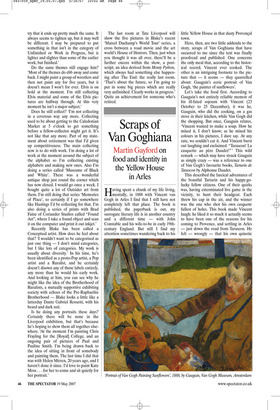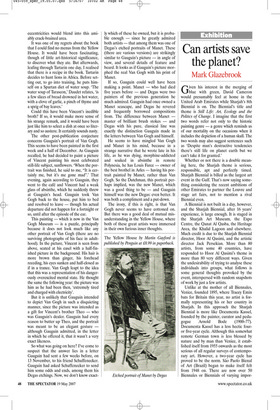Scraps of Van Goghiana
Martin Gayford on food and identity in the Yellow House in Arles
Having spent a chunk of my life living, mentally, in 1888 with Vincent van Gogh in Arles I find that I still have not completely left that place. The book is published, the paperback is out, my surrogate literary life is in another country and a different time — with John Constable and his wife-to-be in early 19thcentury England. But still I find my attention sometimes wandering back to his little Yellow House in that dusty Provençal town.
Here, then, are two little addenda to the story, scraps of Van Goghiana that have occurred to me since the text was finally proofread and published. One concerns the only meal that, according to the historical record, Vincent ever cooked. The other is an intriguing footnote to the picture that — it seems — they quarrelled about: Gauguin’s eerie portrait of Van Gogh, ‘the painter of sunflowers’.
Let’s take the food first. According to Gauguin’s not entirely reliable memoir of his ill-fated sojourn with Vincent (23 October to 25 December), it was he, Gauguin, who did the cooking, on a gas stove in their kitchen, while Van Gogh did the shopping. But once, Gauguin relates, ‘Vincent wanted to make a soup. How he mixed it, I don’t know; as he mixed his colours in his pictures, I dare say. At any rate, we couldn’t eat it. And Vincent burst out laughing and exclaimed: “Tarascon! La casquette au père Daudet!”’ This wild remark — which may have struck Gauguin as simply crazy — was a reference to one of Van Gogh’s favourite books, Tartarin de Tarascon by Alphonse Daudet.
This described the farcical adventures of the boastful Tartarin and his happy-golucky fellow citizens. One of their quirks was, having exterminated live game in the vicinity, to hunt their headgear. Each threw his cap in the air, and the winner was the one who shot his own casquette fullest of holes. This book made Vincent laugh; he liked it so much it actually seems to have been one of the reasons for his coming to Provence, and settling in Arles — just down the road from Tarascon. He felt — wrongly — that his own quixotic eccentricities would blend into this amiably crack-brained area.
It was one of my regrets about the book that I could find no menus from the Yellow House. It would have been fascinating, though of little art-historical significance, to discover what they ate. But afterwards, leafing through Tartarin one day, I realised that there is a recipe in the book. Tartarin decides to hunt lions in Africa. Before setting out, to go into training, he puts himself on a Spartan diet of water soup. ‘The water soup of Tarascon,’ Daudet relates, ‘is a few slices of bread drowned in hot water, with a clove of garlic, a pinch of thyme and a sprig of bay leaves.’ Could this have been Vincent’s inedible broth? If so, it would make more sense of his strange remark, and it would have been just like him to select a dish at once so literary and so austere. It certainly sounds nasty.
The other post-publication conjecture concerns Gauguin’s portrait of Van Gogh. This seems to have been painted in the first week and a half of December. As Gauguin recalled, he had decided to paint a picture of Vincent painting his most celebrated still-life subject, sunflowers. ‘When the portrait was finished, he said to me, “It is certainly me, but it’s me gone mad”.’ That evening, again according to Gauguin, they went to the café and Vincent had a weak glass of absinthe, which he suddenly threw at Gauguin’s head. Gauguin took Van Gogh back to the house, put him to bed and resolved to leave — though his actual departure did not happen for a fortnight or so, until after the episode of the ear.
This painting — which is now in the Van Gogh Museum — is a puzzle, principally because it does not look much like any other portrait of Van Gogh (there are no surviving photographs of his face in adulthood). In the picture, Vincent is seen from above, seated at his easel with a half-finished picture in the background. His hair is more brown than ginger, his forehead receding, his eyes sunken and half-closed as if in a trance. Van Gogh leapt to the idea that this was a representation of his dangerously overexcited mental state. He thought the same the following year: the picture was him as he had been then, ‘extremely tired and charged with electricity’.
But it is unlikely that Gauguin intended to depict Van Gogh in such a disquieting manner, since the picture was intended as a gift for Vincent’s brother Theo — who was Gauguin’s dealer. Gauguin had every reason to butter up Theo, and the portrait was meant to be an elegant gesture although Gauguin admitted, in the letter in which he offered it, that it wasn’t a very exact likeness.
So what was going on here? I’ve come to suspect that the answer lies in a letter Gauguin had sent a few weeks before, on 13 November, to his friend Schuffenecker. Gauguin had asked Schuffenecker to send him some odds and ends, among them his Degas etchings. Now, we don’t know exact ly which of these he owned, but it is probable enough — since he greatly admired both artists — that among them was one of Degas’s etched portraits of Manet. These (there are various versions) are strikingly similar to Gauguin’s picture — in angle of view, and several details of feature and beard. It looks as if Gauguin’s picture morphed the real Van Gogh with his print of Manet.
If so, Gauguin could well have been making a point. Manet — who had died five years before — and Degas were two painters of the previous generation he much admired. Gauguin had once owned a Manet seascape, and Degas he revered and frequently borrowed compositions from. The difference between Manet master of brilliant brush stokes — and Degas with his pure, classical line was exactly the distinction Gauguin made in the letters between Van Gogh and himself.
He seems to have mingled Van Gogh and Manet in his mind, because in a strange narrative that he wrote late in his life, as he was dying, morphine-addicted and soaked in absinthe in remote Polynesia, he has Louis Farce — owner of the best brothel in Arles — having his portrait painted by Manet, rather than Van Gogh. So the Dutchman, this portrait perhaps implied, was the new Manet, which was a good thing to be — and Gauguin himself was the new Degas: even better. It was both a compliment and a put-down.
The irony, if this is right, is that Van Gogh never seems to have cottoned on. But there was a good deal of mutual misunderstanding in the Yellow House, where both of these great artists were immersed in their own furious inner thoughts.











































































 Previous page
Previous page